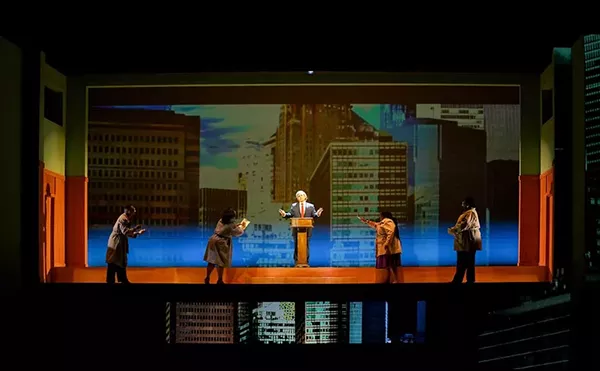

Audio By Carbonatix
[
{
"name": "GPT - Leaderboard - Inline - Content",
"component": "35519556",
"insertPoint": "5th",
"startingPoint": "3",
"requiredCountToDisplay": "3",
"maxInsertions": 100,
"adList": [
{
"adPreset": "LeaderboardInline"
}
]
}
]
British artist Marcus Lyon's latest project, the sprawling "i.Detroit," is many things. Primarily, it's a handsome tome of portraits of 100 notable denizens. The project also includes a mix of high- and low-tech: an auxiliary smartphone app helps bring the subjects' stories to life with sound, and the package even comes with a 7-inch vinyl record featuring music by Brian Eno and Efe Bes. Notably, the project also maps the DNA of its subjects, for a total effect that Lyon calls a "human atlas" of a city. The hefty, nearly 500-page book is dense and lovingly crafted, with too many details to catch in even a dozen sittings.
The project is a reflection of the diversity and nuance here — an angle often overlooked by out-of-town artists parachuting in with their own preconceived notions of what Detroit is all about. Lyon credits that to his skills as a "listener," but also to the locals who guided the project from the beginning.
"You've got a big city there, so we didn't want just people from the '7.2' who were kind of obvious candidates," he says, referring to the number of square miles of the city's revitalized downtown core that gets the most attention. "We wanted to stretch out into the neighborhoods — which for me is really the big story of Detroit. If Detroit is going to truly move to its next incarnation, it needs to bring its neighborhoods with it."
Lyon's first human atlas was Somos Brasil, a project he started in 2014 inspired by his Brazilian wife and their two children, who had dual identities. The project saw Lyon trek across more than 22,000 miles of the country, recording the stories and mapping the DNA of 100 Brazilians. Lyon repeated the formula with We:Deutschland, a project focused on Berlin, in 2016.
Apparently, one of his books landed on the desk of Kresge Foundation CEO Rip Rapson, who immediately wanted to bring the project to Detroit. In 2018, a meeting was brokered between Lyon and a number of community leaders who, as Lyon says, "grilled me for an hour." "They tore me to pieces, like, 'Who are you? Why are you here? What makes you, a white boy from London, think you can tell our story?'" he says.
In the end, Lyon charmed them, and they offered their enthusiastic support of the project.
Next came a six-month nomination process, where Lyon sought recommendations for subjects from across the community. He then vetted that list with local leaders, and paused after he'd amassed 80 or so to see if there were any gaps — geographically, or demographically — that needed to be filled before rounding out the list.
The final list includes notables from all walks of life, including art impresario George N'Namdi, U.S. Rep. Rashida Tlaib, poet jessica Care moore, and even former Metro Times editor Larry Gabriel. Most notably, the majority of the subjects are African American — a reflection of the nearly 80% Black city that is often overlooked by both local and outside media, which tend to gravitate toward the "white hipsters who just found Detroit" narrative. (Lyon admits the book isn't a perfect reflection of the city, with about 70% Black Detroiters, because representing smaller, yet important groups like Chaldeans, Latinos, Jews, and Native Americans inevitably skewed the ratio.)
Next, Lyon scheduled meetings with the subjects to take their photos, as well as a DNA swab — an aspect that Lyon acknowledges can have a painful connotation for members of the African diaspora. "So many of the Black DNA stories talk about stories of slavery," Lyon says. "Most of that is quite dark, but people stepped up." Many of the subjects talk about how they or their ancestors moved to Detroit as part of the Great Migration for "a better chance or a better job, and the middle-class American dream," Lyon says.
Because the subjects were nominated by leaders in the community, Lyon believes that helped him gain their trust. As an additional step, Lyon interviewed them in places of emotional significance to them — like, say, the steps of the library where they grew up, or the park bench on Belle Isle where they first kissed their true love.
"I think that probably helped us get that extra 10% of emotional resonance out of the interviews," he says. "I think it's easy to look at it as numbers and as graphs and graphics, very cold and transactional, but actually there's something incredibly powerful about understanding your origins, especially for a large number of people. It gives you a sense of who you are and where your [roots are] and where you might belong."
Lyon made a number of tweaks for the Detroit project, like honoring the city's musical legacy by asking everyone to pick a song for a Spotify playlist. Another was including the intersection of the roads near where people lived — we are the Motor City after all.
"We'd done 10 interviews before I said to everybody, 'What's this intersection thing?" he says. At that point, he had a eureka moment to include those intersections as a graphic design treatment. Another design easter egg was to italicize the "i" in the title, "because Detroiters are quite 'I' themselves," Lyon says. "They lean into the D. There's that grittiness, that 'I-ness' about being a Detroiter — they'll lean in and be a bit gritty and a little bit punchy with you, but as soon as they decide you're part of the team, they got a hug for you."
Lyon says his hope is to get copies of the book in local independent bookstores, but people can also buy it directly from his studio for about $260. He says he plans to get a digital version of it online so it can be accessible for all, and is even in talks to make it part of the curriculum in Detroit public schools.
Lyon hopes that he can inspire young Detroiters "to realize that there's leadership right within their own communities, and that they don't have to live in the shadow," he says. "They can honor that by becoming leaders or servants themselves."
i.Detroit: A Human Atlas of an American City has a virtual book launch at 11 a.m. on Thursday, Oct. 15; see marcuslyon.com for more information.
We have a new events newsletter! Find out the best things to do in the area every Thursday in your inbox.






